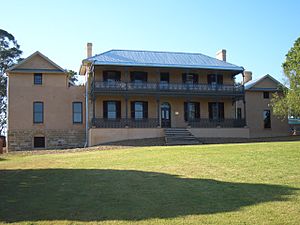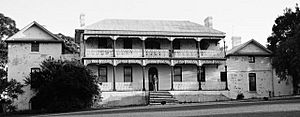Brush Farm facts for kids
Quick facts for kids Brush Farm |
|
|---|---|

Brush Farm House, 2007
|
|
| Location | Marsden Road, Eastwood, City of Ryde, New South Wales, Australia |
| Built | 1794–1894 |
| Owner | City of Ryde |
| Official name: Brush Farm; Home for Boys; Eastwood Home for Mothers and Babies; Brush Farm Home for Mentally Deficient Children Brush Farm Girls' Home | |
| Type | State heritage (complex / group) |
| Designated | 2 April 1999 |
| Reference no. | 612 |
| Type | Homestead Complex |
| Category | Farming and Grazing |
| Lua error in Module:Location_map at line 420: attempt to index field 'wikibase' (a nil value). | |
Brush Farm is a historic place in Eastwood, New South Wales, Australia. It used to be a farm, a home, and even a vineyard. Today, it's a popular spot for tourists, community events, and meetings. It was built between 1794 and 1894. Over the years, it has been known by different names, like the Home for Boys, the Eastwood Home for Mothers and Babies, and the Brush Farm Home for Mentally Deficient Children, and Brush Farm Girls' Home. The City of Ryde now owns this important property. It was added to the New South Wales State Heritage Register in 1999 because of its special history.
Contents
History of Brush Farm
The land around Ryde, where Brush Farm is located, was originally home to the Wallumedegal people. They were a clan of the Dharug-speaking area. This area was great for farming and growing fruit.
In 1792, Governor Phillip gave land grants to soldiers to encourage farming. Later, convicts also received small farms. Important people like John Macarthur, Gregory Blaxland, and Reverend Samuel Marsden bought many of these farms. The area remained important for orchards throughout the 1800s.
Early Owners and Gregory Blaxland
Brush Farm was first part of land given out in 1794. William Cox bought these lands in the early 1800s. He created a large estate of over 200 hectares (500 acres) called Brush Farm.
In 1805, D'Arcy Wentworth bought 184 hectares (455 acres) of Cox's estate. Then, in 1807, Gregory Blaxland bought it. Blaxland was a free settler who came from England in 1806. He was a skilled farmer.
Gregory and his brother John decided to move to New South Wales in 1804. They made deals with the British government for land and help. Gregory arrived in Sydney in 1806.
He first leased "The Vineyard" at Rydalmere. Within a year, he bought Brush Farm from D'Arcy Wentworth.
Blaxland's Vineyard and Exploration
In 1807, Blaxland moved to Brush Farm. He started planting a vineyard nearby. He collected healthy grapevines from all over the colony. Most of these were a type called "Constantia."
Governor Macquarie wanted the Blaxland brothers to grow grain. But they were more interested in cattle and sheep. They supplied a lot of meat to the government, which helped lower its price.
In 1812, a drought made Blaxland want more land. This, and the challenge of the mountains, pushed him to explore.
In 1813, Blaxland, with Lieutenant William Lawson and William Charles Wentworth, made the first successful crossing of the Blue Mountains. When they returned, Governor Macquarie rewarded each explorer with 400 hectares (1,000 acres) of land.
Winemaking Success
Gregory Blaxland brought grape cuttings from other countries during his trip to NSW. He planted these at Rydalmere. He also found good grapevines already growing in the colony. He later moved his vineyard closer to Brush Farm House. He planted new types of grapes, including what he thought were Claret grapes.
After some challenges, Blaxland made good wine in 1816. He sent samples to Governor Macquarie. In 1816, the Royal Society for the Arts in England offered medals for wine from New South Wales.
Blaxland developed Brush Farm into a successful farm. By 1817, he was producing meat and livestock. He also had a place to make wine and vinegar. He was a founding member of the first Agricultural Society of NSW. He also brought buffalo grass to the colony, which was good for cattle.
Before 1819, he planted another vineyard on the slopes near Brush Farm House. He used terracing, a method he learned from a stop in Madeira. In this vineyard, he planted French wine grapes like Shiraz and Pinot.
In 1821, Blaxland had three and a half acres of grapevines at Brush Farm.
Building Brush Farm House
Blaxland built the current Brush Farm House around 1820. It was the second house on the farm. The first was a smaller building down the gully. A shale mine on the farm likely provided materials for the house.
The main part of the house was built around 1819-1820. It was a two-story building with sandstone foundations and brick walls. East and west wings were added in the 1820s. The property also had stables and landscaped gardens.
Because of its high location, a spot on the property was used as a signal station. It relayed messages about ships arriving at Sydney to Government House at Parramatta.
In 1822, Blaxland sent wine to England. Some of it was for the Royal Society for the Arts. In 1823, Blaxland's wine won a silver medal as the best wine produced in NSW at the time. He was the first to export a commercial amount of wine from Australia.
Five years later, in 1828, he won a Gold Ceres medal for his wine. Blaxland's Brush Farm was once considered the best vineyard in the colony.
In 1825, James Busby wrote books about growing grapes and making wine. He brought 437 grape cuttings to NSW in 1833. Busby said Blaxland's vineyard was a showplace in the Sydney Basin. Cuttings from Brush Farm helped start vineyards like Wyndham Estate in the Hunter Valley.
In 1829, the signal station on the property was stopped. Early photos show a clear view from the house to the Parramatta River.
Later Owners and Uses
Between 1831 and 1835, the property was listed as One Tree Hill. In 1831, Blaxland faced money problems and sold Brush Farm to his son-in-law, Thomas Forster. Forster continued the tradition of growing grapes and making wine.
In 1844, the property was leased to William Forster, Gregory Blaxland's grandson. William Forster later became the NSW Premier from 1856 to 1860.
In the 1880s, the property was divided and parts were sold. John Bennett, a theatrical businessman, acquired Brush Farm. He saw an opportunity because it was close to the Northern Railway Line and Eastwood station. Bennett's wife, Emma, acquired the part with the house. Changes were made to the house around 1883, including adding the front verandah.
In 1894, Emma Bennett leased her part of the property to the government. It became the Carpentarian Reformatory for Boys. It housed boys who had been on the 'Sobraon', an old ship used for homeless boys. The boys were trained in skills like farming and metalwork.
In 1904, the State Government took over the property. It continued as a reformatory for boys until 1913. After the boys left, the property was used for girls who needed guidance around 1911. Later, it became a home for single mothers and then for children with special needs.
In 1918, the Eastwood Home for Mothers and Babies opened at Brush Farm. From 1921, it became the Brush Farm Home for Mentally Deficient Children.
Since the 1970s, the surrounding gullies have been restored by the community. In 1988, the property was transferred to Corrective Services NSW and became the Brush Farm Corrective Services Academy.
In 1990, the Ryde Municipal Council bought Brush Farm House and its surrounding land. The Council began restoring the house in 2006. Funds came from the Council and government sources.
In 1999, the property was listed on the State Heritage Register. In 2005, Ryde City Council started a major restoration of Brush Farm House to use it as a community venue. The house officially reopened in 2007. The Council plans to use it for cultural events, art shows, meetings, and weddings.
The Brush Farm & District Historical Society has worked hard to preserve and reopen Brush Farm Estate to the public. They study local history, collect documents, and promote the importance of Brush Farm. They also organize tours for school groups and open days.
In 2008 and 2009, a plan was approved to restore the garden and carriage drive around the house. The house is now used for community events, art shows, and tours.
Description
Brush Farm House is located at the corner of Lawson Street and Marsden Road. It is a rare example of an early colonial mansion and a remaining farm in the Ryde area. The house and other buildings share an entry point. The original property was much larger, covering parts of Eastwood, Dundas, Lambert, and Brush Farm Parks.
Recent Changes
A restoration program for Brush Farm House began in December 2004. Key steps included hiring architects and getting approvals. Work started in May 2006.
The first phase of work included repairing and rebuilding the floor and roof structures. New toilets were installed, and archaeological investigations were carried out. The second phase of work was completed by April 2007.
The goal was to repair, restore, and stabilize the building. This helped fix its seriously damaged condition.
Heritage Significance
Brush Farm House is a rare and important example of an early colonial mansion in the Ryde area. It was built by Gregory Blaxland, a key figure in the colony's history. The house shows his important position.
Blaxland was involved in many types of farming. He was a pioneer in agriculture. One of his big achievements at Brush Farm was setting up Australia's first vineyard. By the 1820s, his wine had won awards.
The house also shows how the family's fortunes changed and how building styles evolved. Important additions were made after Blaxland's successes in the 1830s. His grandson, William Forster, updated the building in the late 1800s. Forster was an important politician in NSW.
The building's change into the Carpentarian Boys Academy in 1894 shows changing views on children who needed care. The academy trained boys in farming and trades to prepare them for adult life. After the academy moved, the site was used for various government institutions. These included a home for single mothers and later for girls who needed guidance.
Parts of the building from all these periods still exist. This includes the original core of the house from around 1816 and a timber hall added later. Even though it was in poor condition, the building has been restored.
The land around Brush Farm House is also very important. It has rare remains of vineyard terraces, which are nationally significant. There are also rare types of rainforest and wet sclerophyll forest. These are identified as endangered ecological communities. The area also has important archaeological sites that show how the estate developed over time. There are still views from Brush Farm House to the Parramatta River and the Blue Mountains.
Brush Farm is historically important because of its connection to Gregory Blaxland, the explorer and winemaker. It played a big part in the start of the Australian wine industry. After many challenges, Blaxland made good wine from Brush Farm in 1816. The Royal Society of Arts in London gave him a silver medal in 1823 and a gold medal in 1828 for his colonial wine. Blaxland's vineyard at Brush Farm was once called the best in the colony.
Brush Farm was listed on the New South Wales State Heritage Register on 2 April 1999.
Images for kids



